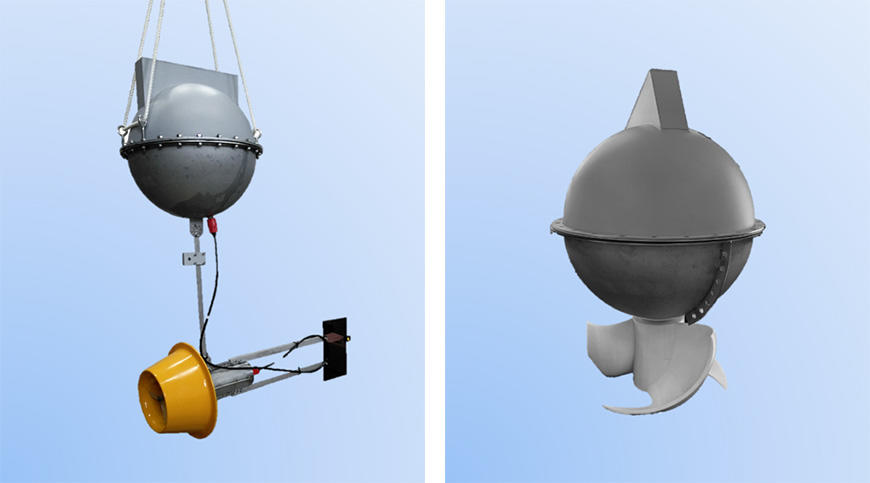Nagasaki University (President: Shigeru Kohno) and Kyocera Corporation (President: Hideo Tanimoto) announced their joint development of an Energy Harvesting Smart Buoy, which combines Nagasaki University's tidal current power generation technology with Kyocera's IoT technology to collect reliable ocean data. Prototype buoys can collect a wide range of data on the marine environment using self-generated energy. A pilot program gathered information from 21 sensors, monitoring everything from water temperature and humidity to current direction. Future development may include sensors for temperature-related salinity variation, chlorophyll turbidity, and temperature-related variations in dissolved oxygen concentrations, to name a few.

Energy Harvesting Smart Buoys
Left: SLTT (Small Lens-type Tidal Turbines),
Right: VTT (Vertical-axis Tidal Turbines)
■Development Background
Marine pollution and climate change have become serious societal issues. To solve these issues and help create a more sustainable world, scientists need more reliable ways to monitor and visualize various sea conditions. However, maintaining a stable power supply is a big challenge for continuous data collection at sea. Therefore, Nagasaki University and Kyocera developed the "Energy Harvesting Smart Buoy," which generates its own electric power for continuous ocean data collection using a tidal-current power generation system in the buoy. The new Smart Buoy combines tidal-current power generation technology from Nagasaki University and IoT-related technology from Kyocera. In addition, Kyocera has future plans to monitor fisheries and aquaculture, conduct ocean surveys, and more.
*1 Equipped with a general-purpose serial interface (RS-485), it can connect sensors according to application.
*2 GLONASS is a positioning system using Russian satellites. Michibiki is a Japanese satellite positioning system consisting mainly of quasi-zenith orbiting satellites.
Each prototype is equipped with two different tidal-current power generation systems:
SLTT (Small Lens-type Tidal Turbines) - The buoy and power generation are separate, and a diffuser is installed around the turbine. In addition to protecting the turbine, the diffuser has the effect of increasing the flow of water for better power generation.
VTT (Vertical-axis Tidal Turbines) - The power generation element is directly connected to the buoy. Its AI-guided design incorporates a tilted axis to optimize turbine rotation amid heavy ocean swells and waves.

* PAL Co., Ltd., and Shinei Kogyo LLC., both of which are based in Nagasaki City, cooperated in the prototype manufacturing of the buoy.
■Pilot Test Results in Sea
Nagasaki University and Kyocera conducted a pilot test for nine days during spring tide to low tide in the tidal cycle. The test used 21 sensors to collect data which was then transmitted to the cloud, including acceleration, temperature, and humidity (using geomagnetic sensors inside the buoy), water temperature, flow velocity, current direction, battery current, and voltage (using an external electric current sensor)
The average amounts of electricity generated and consumed during the experiment were:
*Experimental results of SLTT
■Future Initiatives
To promote ongoing ocean monitoring, the companies are planning to support a water temperature-salinity sensor (temperature, salinity, and electrical conductivity), chlorophyll turbidity sensor (chlorophyll, turbidity, and water temperature), DO sensor (dissolved oxygen and water temperature), and an underwater camera. Performance and operation will be improved, along with a reduction in size and weight, in commercial versions. Kyocera will also build an IoT platform to store collected data, and ongoing testing will be conducted mainly in Nagasaki Prefecture.
*LTE is a trademark of ETSI.

Energy Harvesting Smart Buoys
Left: SLTT (Small Lens-type Tidal Turbines),
Right: VTT (Vertical-axis Tidal Turbines)
■Development Background
Marine pollution and climate change have become serious societal issues. To solve these issues and help create a more sustainable world, scientists need more reliable ways to monitor and visualize various sea conditions. However, maintaining a stable power supply is a big challenge for continuous data collection at sea. Therefore, Nagasaki University and Kyocera developed the "Energy Harvesting Smart Buoy," which generates its own electric power for continuous ocean data collection using a tidal-current power generation system in the buoy. The new Smart Buoy combines tidal-current power generation technology from Nagasaki University and IoT-related technology from Kyocera. In addition, Kyocera has future plans to monitor fisheries and aquaculture, conduct ocean surveys, and more.
| ■Outline of the Prototypes A buoy equipped with a tidal-current power generation system supplies power to the Kyocera GPS multi-unit and connected sensors*1. The GPS multi-unit is a compact Kyocera IoT device, equipped with various sensors and antennas, compatible with GPS, GLONASS, and Michibiki*2 location tracking systems. |
 GPS multi-unit |
*1 Equipped with a general-purpose serial interface (RS-485), it can connect sensors according to application.
*2 GLONASS is a positioning system using Russian satellites. Michibiki is a Japanese satellite positioning system consisting mainly of quasi-zenith orbiting satellites.
Each prototype is equipped with two different tidal-current power generation systems:
SLTT (Small Lens-type Tidal Turbines) - The buoy and power generation are separate, and a diffuser is installed around the turbine. In addition to protecting the turbine, the diffuser has the effect of increasing the flow of water for better power generation.
VTT (Vertical-axis Tidal Turbines) - The power generation element is directly connected to the buoy. Its AI-guided design incorporates a tilted axis to optimize turbine rotation amid heavy ocean swells and waves.

* You can scroll this table sideways.
| SLTT | VTT | |
| Size |
Total :Approx. 1800mm |
Total :Approx. 910mm |
| Weight | Approx. 32kg | Approx. 31kg |
| Battery | Tidal power generation + Secondary battery(54,000mA) | |
| External sensor | Current meter (Velocity, direction of flow, and water temperature) |
|
| Internal sensor | Temperature and Humidity/Acceleration/Charging current/Battery voltage/Leakage detection | |
| Location information | GPS / GLONASS / Michibiki*2 | |
| Antenna | Built-in | |
| Communication method | LTE* Cat.M1(LTE-M) | |
| Compatible band | B1/B8/B19/B26 | |
| SIM | nano SIM | |
* You can scroll this table sideways.
| Organization Name | Role |
| Nagasaki University | Turbine design optimized for tidal-current power generation |
| Kyocera | Development of various sensor controls, power control, buoy design, cloud applications, and mobile applications |
■Pilot Test Results in Sea
Nagasaki University and Kyocera conducted a pilot test for nine days during spring tide to low tide in the tidal cycle. The test used 21 sensors to collect data which was then transmitted to the cloud, including acceleration, temperature, and humidity (using geomagnetic sensors inside the buoy), water temperature, flow velocity, current direction, battery current, and voltage (using an external electric current sensor)
The average amounts of electricity generated and consumed during the experiment were:
* You can scroll this table sideways.
| Average power generation | 16.3 Wh |
| Average power consumption | 15.2 Wh |
| Sensing interval | 5 Minutes |
| Data transmission interval | 5 Minutes |
■Future Initiatives
To promote ongoing ocean monitoring, the companies are planning to support a water temperature-salinity sensor (temperature, salinity, and electrical conductivity), chlorophyll turbidity sensor (chlorophyll, turbidity, and water temperature), DO sensor (dissolved oxygen and water temperature), and an underwater camera. Performance and operation will be improved, along with a reduction in size and weight, in commercial versions. Kyocera will also build an IoT platform to store collected data, and ongoing testing will be conducted mainly in Nagasaki Prefecture.
*LTE is a trademark of ETSI.





